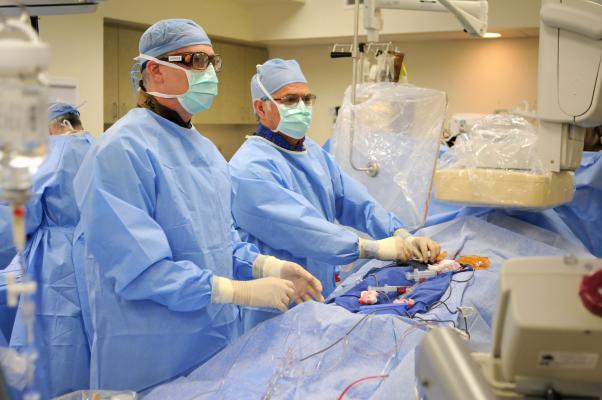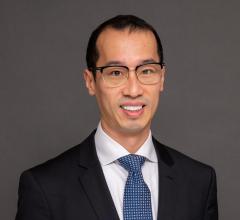Transcatheter aortic valve replacement (TAVR) is not only a breakthough minimally invasive medical therapy, but offers a new business opportunity for hospitals that begin a program. The technology is viewed as cutting edge not only with clinicians, but also among the general public. This can be leveraged to promote the hospital as a cutting-edge facility and help attract new patients. However, creating these programs requires long-term financial, professional and equipment commitments, which may not be right for all hospitals. There are also concerns that a proliferation of TAVR centers may make programs less profitable and reduce the proficiency of any one center as patient volumes decrease if patients are spread between many competing hospitals.
Hospitals Say ROI is From Surgery, Not TAVR
The initial experience of TAVR centers that began programs immediately after U.S Food and Drug Administration (FDA) approval of the first TAVR device in November 2011 was that referrals increased. However, between new referrals and patients seeking out transcatheter valve programs on their own initiative, the majority of these patients did not meet the narrow indication for TAVR. Most of the patients who did not qualify, however, often stayed with the hospitals for surgical aortic valve replacement (SAVR). Centers said the current costs to start a TAVR program and the combined costs of the devices and care actually make the transcatheter procedure more expensive, despite the minimally invasive nature of the procedure and shorter hospital stays. However, most centers agree that while TAVR was not initially a windfall of new profits, the programs did attract more patients by default to their surgical programs, thus boosting surgical procedure volume.
“Before the program started, we were doing 220 surgical aortic valve cases. Now we are doing about 340,” said
Wes Pedersen, M.D., FACC, FSCAI, director transcatheter valve therapy program, interventional cardiology at the
Minneapolis Heart Institute Foundation, Abbott Northwest Hospital. He said the hospital has seen a 10-percent increase in conventional surgical patients after the implementation of a TAVR program.
Costs to Develop a TAVR Program
Minneapolis Heart Institute Foundation did not have a hybrid operating room (OR) before the TAVR program. “That’s the biggest expense,” said Pedersen, who explained it takes about $5 million to build out a hybrid OR.
To pay for itself, Pedersen said a hospital should aim to perform 60-80 TAVRs a year. If a facility does not need to build a hybrid OR, Pedersen said about $1 million is needed to get started. This includes between $500,000 — $600,000 for infrastructure, including full-time employees and computer networks. These components are needed partly to supply procedural data to the combined Society of Thoracic Surgeons (STS) and American College of Cardiology (ACC) Transcatheter Valve Therapy (TVT) Registry, which is mandatory. Additional costs are incurred when purchasing the valves and delivery systems from valve companies (Edwards Lifesciences and Medtronic). Pedersen said the vendors require hospitals purchase the valves up front — about $200,000 worth, which is about six valves.
A hybrid OR includes all the same sterility, ventilation and open procedure requirements as a normal OR, but has additional equipment to facilitate interventional procedures. This is usually centered around a fixed-based, high-end angiography imaging system. Some hospitals have opted for less expensive hybrid catheterization labs, which offer many of the features of a hybrid OR but without many of the provisions needed for true open-chest surgical procedures.
The
Henry Ford Center for Structural Heart Disease, located in Detroit, Michigan, began its TAVR program in March 2012. The hospital already had a hybrid OR before implementing the program. But, due to an increase in the volume of TAVR patients, the facility built a second hybrid cath lab to accommodate the growing traffic.
Besides needing a hybrid OR and possibly extra equipment, a plan needs to be in place before an institution decides to open a transcatheter program, said interventional cardiologist
Adam Greenbaum, M.D., co-director of the Henry Ford Center.
Deciding on Creating a Transcatheter Valve Program
Greenbaum’s advice for other hospitals that wish to implement a transcatheter valve program is to determine if the finances and long-term needs of the program can be met.
“My advice would be that [the staff] sit down up front and make sure that this is a program that they truly want to have,” Greenbaum said. “It does take a dedication in terms of financial resources and it takes a time commitment in terms of establishing the necessary multidisciplinary meetings and clinics to see these patients. It requires dedicated technicians and staff. It requires dedicated builders who understand the regulations regarding this technology. It involves input and buy-in from multiple people within the institution. The hospital administration and the physicians should make sure that this is indeed the program they want to start.”
Pedersen advises that before a hospital implements a TAVR program, they need to understand the magnitude of this decision. He said a hospital needs to be committed to creating a dedicated program, not just viewing it as an add-on service.
“I think one of the biggest mistakes people make is that they try to start it with virtual programs. No one really owns it from the morning to the evening at the end of the day. They don’t have a special clinic time so they squeeze [potential TAVR] patients in their regular cardiac clinic, and the nurse practitioners are not only doing structural heart, but she’s doing the typical coronary work, heart failure and everything else. It became apparent to me right out of the starting gate that whoever does this needs to be fully dedicated, not part-time. And that’s a hard thing because if you are a small group how can you do that. We have 55 cardiologists. If you are a 10-man group you can’t afford to do it, and that gets into one of the problems for smaller groups doing this — they don’t have the capacity to build the infrastructure and supply the manpower.”
Selecting Tranacatheter Valve Patients
Transcatheter aortic valves are covered by Medicare if it follows the approved FDA-cleared indications for the treatment of symptomatic aortic valve. These conditions include:
1. The procedure is furnished with a complete aortic valve and implantation system that has received FDA premarket approval for that system’s FDA-approved indication.
2. Two cardiac surgeons have independently examined the patient face-to-face and evaluated the patient’s suitability for open surgical aortic valve replacement (SAVR) surgery; and both surgeons have documented the rationale for their clinical judgment and the rationale is available to the heart team.
3. The patient (pre-operatively and post-operatively) is under the care of a heart team — a cohesive, multidisciplinary team of medical professionals.
Pedersen said he always tells patients there are four groups of patients: inoperable (50 percent likelihood of dying or having an irreversible problem), high-risk (9-15 percent), intermediate risk (4-8 percent) and low risk (2 percent or less). “Currently, we only have FDA approval for the two worst groups,” he said. Over time as more clinical trial data is gathered, this will change to include less sick patients. His hospital currently includes intermediate risk candidates by research protocol.
Minneapolis Heart Institute does not have an age cutoff for patients that want to be considered for the transcatheter aortic valve replacement program. “I have seen people who are 85 or 80 and were way too old physiologically to undergo TAVR,” Pedersen said. “At the young end people can have co-morbidities: a ton of radiation to their chest; they can have terrible lung disease; they can have coagulation disorders and be disabled and not be able to undergo open surgical rehabs. You have to keep an open mind and not use age as a cutoff. We sort of take everyone and screen everyone and we don’t rule anyone out. We can have a 75-year-old, no co-morbidities and they are an excellent surgical candidate, and the FDA and CMS have made it clear that they are not going to reimburse for those.”
At Henry Ford Hospital, all of its patients who are potential candidates for TAVR are reviewed in a multidisciplinary structural heart disease meeting where imaging specialists, cardiologists and surgeons all meet in the same room to determine appropriate candidacy. “Every patient goes through that same process,” Greenbaum said. “Most patients who come through our clinic do go on to transcatheter aortic valve repair as opposed to open surgery.”
Greenbaum explains that most patients do go on to receive this TAVR because to some degree they have been pre-selected, meaning the referring physicians already know that they are probably better served with TAVR and meet the FDA criteria. “Those who are operative candidates that will benefit from open surgical repair don’t often come to our clinic,” he explained. “They are usually sent straight to the surgeons.”
Promoting TAVR Programs
TAVR is viewed by the general public as a cutting-edge technology, which translates into a marketing tool for hospitals with these programs to attract new patients. TAVR, like any advanced medical technology can be leveraged to generate more referrals. In an era of medical consumerism, Internet-savvy patients also self-refer themselves to hospitals they view as having the most advanced technology.
Henry Ford Hospital is located in a highly competitive market in the Detroit metro area, where there are numerous hospitals with TAVR programs. To compete, Henry Ford Hospital has done various types of advertising to highlight its program, which included mailing flyers/advertisements to surrounding physicians to boost referrals, doing radio and TV advertisements (along with other various media messages to raise awareness with the general public) and giving continuing medical education (CME) seminars for the hospital's physicians.
“I think competition is always good for many things,” Greenbaum said. “I don’t know what is the most appropriate number of TAVR programs there ought to be to handle a certain population, and maybe it is the number that there are; or maybe it is less. I think in an open-market system, hospitals are going to build the programs where they want to build them.”
Pedersen’s facility works closely with two hospitals in the Minneapolis area, so advertising its program is kept to a minimum. “We are afraid of offending the other sister hospitals in the community. We have always stayed away from the direct advertising,” he explained.
Most of Minneapolis Heart Institute’s advertising comes in the form of news pieces, both TV and newspaper. “These patients want to hear about the latest and greatest because they are not candidates for these things and they are looking for miracle cures,” Pedersen said. “When you are in the newspaper frequently about new devices that you have, your hospital gets recognized that way as a premier center.”
In terms of referral hospitals, he said it is very important to go out and give talks to all these centers so they identify with you, get to see your face, know your voice and trust you.
What is Required for CMS Reimbursement
The Centers for Medicare and Medicaid Services (CMS) covers TAVR with evidence of development under certain conditions.
If a hospital wants to implement a program it must have the appropriate infrastructure that includes, but is not limited to:
• On-site heart valve surgery program
• Cardiac catheterization lab or hybrid OR/catheterization lab equipped with a fixed radiographic imaging system with flat-panel fluoroscopy
• Non-invasive imaging such as echocardiography, vascular ultrasound, computed tomography (CT) and magnetic resonance (MR)
• Sufficient space in a sterile environment to accommodate necessary equipment for cases with and without complications
• Post-procedure intensive care facility with personnel experience in managing patients who have undergone open-heart valve procedures
• Appropriate patient volume requirements per the applicable qualifications
If a hospital has no prior TAVR experience, CMS requires that the hospital program have 50 total SAVRs in the previous year prior to TAVR, including 10 high-risk patients and two physicians with cardiac surgery privileges and 1,000 catheterizations per year; catheterizations must include 400 percutaneous coronary interventions per year.
The hospital’s heart team must include: a cardiovascular surgeon with 100 career SAVRs including 10 high-risk patients, or 25 SAVRs in one year or 50 SAVRs in two years, which includes at least 20 SAVRs in the last year prior to TAVR initiation; an interventional cardiologist with personal experience with 100 structural heart disease procedures lifetime or 30 left-sided structural procedures per year, of which 60 percent should be balloon aortic valvuloplasty (BAV); echocardiographers, imaging specialists, heart failure specialists, cardiac anesthesiologists, intensivists, nurses, social workers and device-specific training as required by the manufacturer.
Related Transcatheter Aortic Valve Content:



 April 09, 2024
April 09, 2024 








